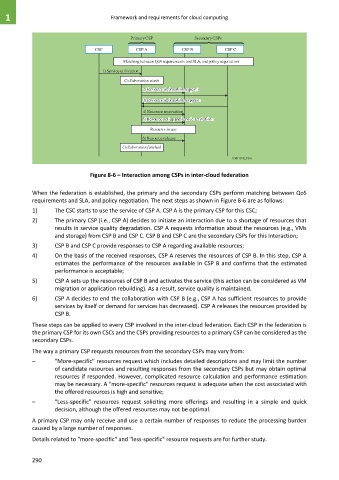Page 298 - Cloud computing: From paradigm to operation
P. 298
1 Framework and requirements for cloud computing
Primary CSP Secondary CSPs
CSC CSP A CSP B CSP C
Matching between QoS requirements and SLA, and policy negotiation
1) Service utilization
Collaboration starts
2) Resource information request
3) Resource information response
4) Resource reservation
5) Resource set-up and service activation
Resource in use
6) Resource release
Collaboration finished
Y.3511(14)_F8-6
Figure 8-6 – Interaction among CSPs in inter-cloud federation
When the federation is established, the primary and the secondary CSPs perform matching between QoS
requirements and SLA, and policy negotiation. The next steps as shown in Figure 8-6 are as follows:
1) The CSC starts to use the service of CSP A. CSP A is the primary CSP for this CSC;
2) The primary CSP (i.e., CSP A) decides to initiate an interaction due to a shortage of resources that
results in service quality degradation. CSP A requests information about the resources (e.g., VMs
and storage) from CSP B and CSP C. CSP B and CSP C are the secondary CSPs for this interaction;
3) CSP B and CSP C provide responses to CSP A regarding available resources;
4) On the basis of the received responses, CSP A reserves the resources of CSP B. In this step, CSP A
estimates the performance of the resources available in CSP B and confirms that the estimated
performance is acceptable;
5) CSP A sets up the resources of CSP B and activates the service (this action can be considered as VM
migration or application rebuilding). As a result, service quality is maintained.
6) CSP A decides to end the collaboration with CSP B (e.g., CSP A has sufficient resources to provide
services by itself or demand for services has decreased). CSP A releases the resources provided by
CSP B.
These steps can be applied to every CSP involved in the inter-cloud federation. Each CSP in the federation is
the primary CSP for its own CSCs and the CSPs providing resources to a primary CSP can be considered as the
secondary CSPs.
The way a primary CSP requests resources from the secondary CSPs may vary from:
– "More-specific" resources request which includes detailed descriptions and may limit the number
of candidate resources and resulting responses from the secondary CSPs but may obtain optimal
resources if responded. However, complicated resource calculation and performance estimation
may be necessary. A "more-specific" resources request is adequate when the cost associated with
the offered resources is high and sensitive;
– "Less-specific" resources request soliciting more offerings and resulting in a simple and quick
decision, although the offered resources may not be optimal.
A primary CSP may only receive and use a certain number of responses to reduce the processing burden
caused by a large number of responses.
Details related to "more-specific" and "less-specific" resource requests are for further study.
290

